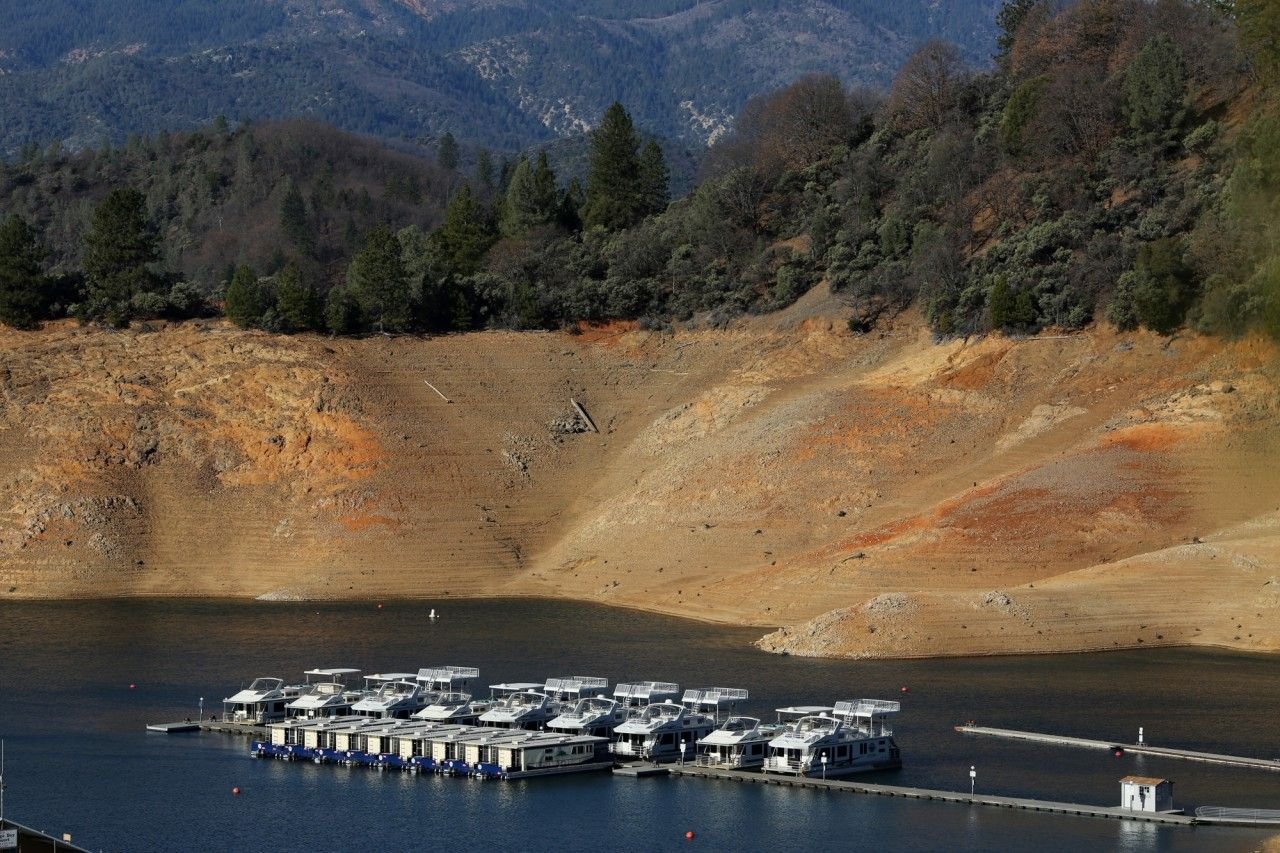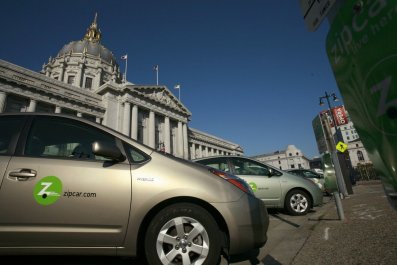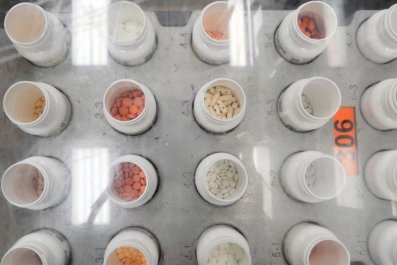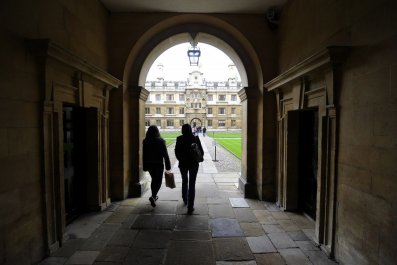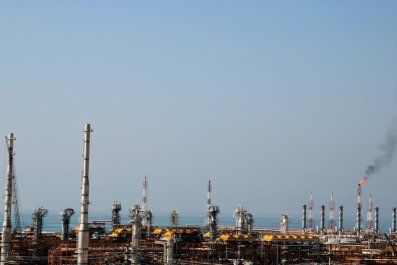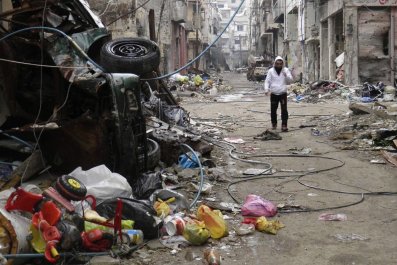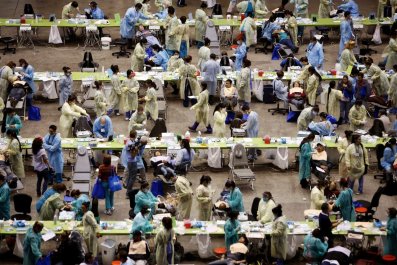Lompico, Calif., is running out of water. The idyllic community of around 1,200 is tucked into a canyon in the Santa Cruz mountains, where majestic redwoods are common features of people's backyards. Last week, Lompico appeared on a list of 17 rural districts that the state says may completely deplete their water supply in 60 to 120 days.
"As the drought goes on, there will be more that probably show up on the list," Dave Mazzera, acting drinking-water division chief for the state Department of Public Health, told reporters.
It is hard to imagine what that means in absolute terms: Lompico's approximately 500 homes get their water from three wells that draw on an underground aquifer. Aquifers are replenished by rainfall that seeps through the ground, which is a very slow process under normal conditions. California is three years deep into the worst drought the state has ever seen, and levels in the Lompico aquifer are dropping, as demand for water outstrips the rate at which it can be replenished. Even the Lompico creek, which might have been able to make up for part of the difference, has been all but dry since August. Lompico is largely out of options.
For Lois Henry, who has lived in Lompico for 43 years and has sat on the board of its water system for the past five, the situation is dire.
"I've never seen a drought like this," she tells Newsweek. "We have no water supply here other than what is right here in the county. We don't get water from the Colorado River, or the Hetch Hetchy [reservoir near Yosemite], or the San Joaquin Delta. We just have the water that's here," and there's simply not enough.
With approximately seven inches of rain in California in 2013 (compared to the average 22 inches), Governor Jerry Brown declared a drought emergency in January. Many reservoirs in the state are only 30 percent full, and the Sierra snowpack, a major source of California water, is at only 12 percent of its normal water content for this time of year.
While Lompico is running out of its own water, other parts of the state are about to be cut off from shared state reservoirs. Brown has called for a 20 percent voluntary reduction of water use for Californians, and many local communities have imposed mandatory cuts to individual water use. In Lompico, the water district has asked its customers to cut use by 30 percent.
Scientists have determined that extremely dry conditions will likely persist in California due to climate change, which a recent study concluded will cause droughts to "set in quicker and be more intense." The American Meteorological Society intends to take up the question of climate change's role in the current drought later this year.
"I know that there are periods of drought. It happens. There was the dust bowl in the 1930s. They're probably fine now," Henry says. "I'm hoping that this isn't a permanent climate change. What would happen to the redwoods?"
B. Lynn Ingram, a paleoclimatologist at the University of California, Berkeley, believes California will recover from this drought. But she warns that the region's history of extremely long droughts, lasting decades or more, must be taken into account.
The West is on track for having the driest water year [which began October 1] in about 500 years "or even longer," Ingram tells Newsweek.
Based on tree-ring records of giant sequoias in the Sierra Nevada mountains, she believes California hasn't been this dry since 1580, when narrow or even absent rings indicated that "it was so dry those trees failed to grow." She recently published the research in the alarmingly titled book The West Without Water.
Paleoclimatologists have discovered evidence of droughts that lasted over a century during the Medieval Warm Period, especially in the southern half of California. That's right during the time of the so-called "Anasazi collapse," when Native Americans migrated en masse away from the four corners region, and skeletal remains show "signs of starvation, disease, infant mortality and violence, suggesting extreme hardship and competition for dwindling water and food resources," Ingram says. Ingram sees some analogy between the Anasazi's story and the current drought crisis. During the wet years prior to that medieval mega-drought, their population size had grown, much like ours has, "leaving them more vulnerable when the climate changed."
"If we look further back in the paleoclimate record, we see there were even larger droughts [more than a decade], that occurred regularly [every 30 to 90 years]," Ingram says. "So we really do need to plan ahead and prepare for drier conditions."
Tim Quinn, the executive director of the Association of California Water Agencies, is one of the people whose job it is to think about what those preparations might look like. "We know we're going to have another one in the next decade, and we have to be ready for it," he tells Newsweek.
Storing large amounts of water in emergency reservoirs is key, according to Quinn. Southern California water districts invested in storage after the area was hit by drought in 1997, and drawing on that emergency source has prevented that region from facing the brunt of the "off-the-charts-scary" drought happening now, Quinn says.
But communities located at higher elevations like Lompico are worse off: They have fewer places to turn when their streams and wells start drying up, due to the much-decreased snowpack this year and aquifers that are "already in overdraft," Quinn says.
"Unless a miracle happens, they'll be looking at 30 to 50 percent mandatory rationing" in mountain areas, Quinn tells Newsweek.
For now, Lompico has enough water to limp by. But Henry says one of the town's three wells has recently been cutting out, reducing even further the approximately 35 gallons per minute the district is able to pump to its 494 water hookups. The water supply is so precarious, Henry says, that Lompico is one water main break or major fire away from disastrously low levels.
Directing people to use less water also means less money in water payments will come in to help finance a potential new well, or repairs on the one that's in disrepair.
"It's like you can't win," Henry says.
Lompico is in discussions with neighboring San Lorenzo for a water-district merger, which would alleviate the situation. But with upwards of 90 percent of the state suffering the drought, a huge increase in rainfall is the only long-term solution.
As a last-ditch measure, water may be able to be trucked in or brought in by pipeline to rural places like Lompico, Quinn says. If those areas do reach the end of their water supply, people may leave their homes. "That's certainly not beyond the realm of the possible," Quinn says. "Life gets pretty tough when you can't get water."
But Henry says she has never once thought of leaving. Besides, how could she? Selling a home in a drought-affected area would be almost impossible.
"What am I going to do? I'm retired, this is my home. My house is paid for free and clear. You just don't walk away from something like that."



